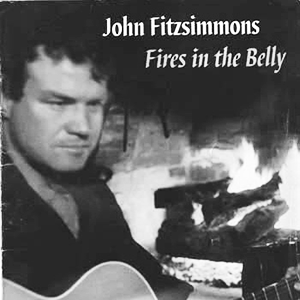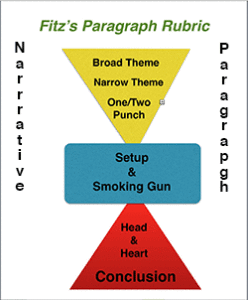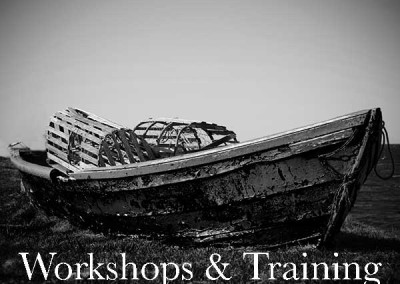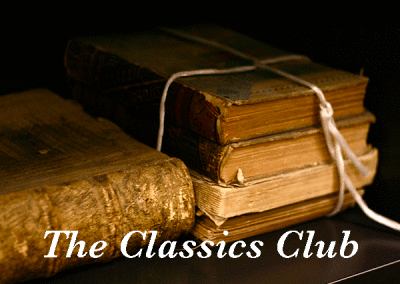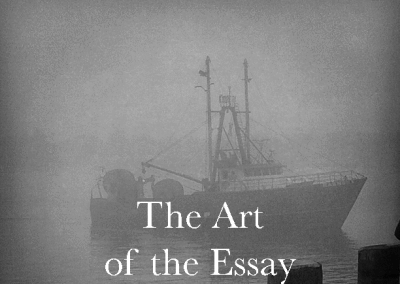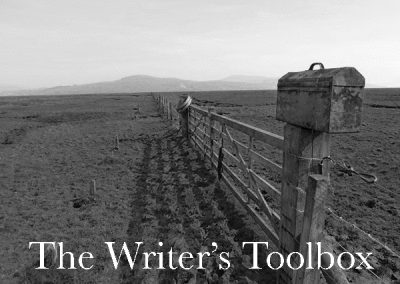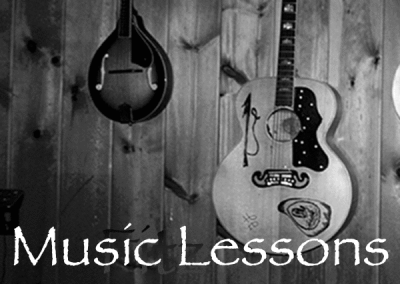TheCraftedWord.org
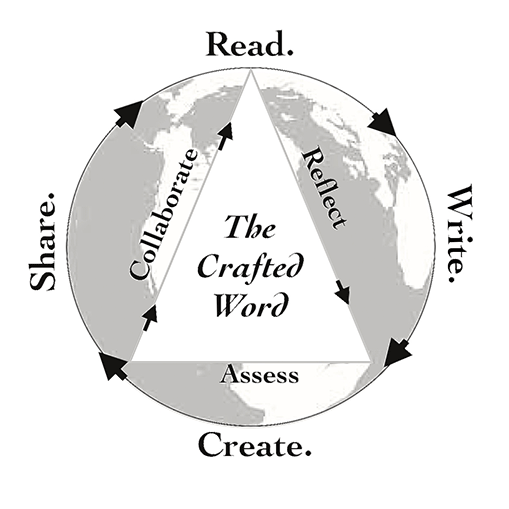
Tell Your Story
Paragraph & Punctuation
The Power of Experience
Workshop One: Capturing an Experience in Words
Click Here To Join the iTunes U Course for Free
Some thoughts before we get started…
The Power of Paragraphs
What Paragraphs Are & What They Do
Moreover, I, on my side, require of every writer, first or last, a simple and sincere account of his own life, and not merely what he has heard of other men’s lives
~Henry David Thoreau
 If some alien linguists came to earth to study how we communicate with each other, they would probably return to Alien World University and tell their scholarly alien brethren how we create and assign words to our thoughts, and then we share these words either by sound (by talking with each other) or by changing those sounds into a strange and silent written language (written words) that tries to recreate the way we humans talk with each other. Further study would show that we group our thoughts (and hence words) into blocks that we call sentences and paragraphs. Sometimes we group a series of related paragraphs together into an essay, or a speech, or a story. In short, they might say that we communicate using a trinity of expression: a sentence is a thought fully expressed; a paragraph is a thought fully explained; while an essay (or any longer writing piece) is a thought fully explored.
If some alien linguists came to earth to study how we communicate with each other, they would probably return to Alien World University and tell their scholarly alien brethren how we create and assign words to our thoughts, and then we share these words either by sound (by talking with each other) or by changing those sounds into a strange and silent written language (written words) that tries to recreate the way we humans talk with each other. Further study would show that we group our thoughts (and hence words) into blocks that we call sentences and paragraphs. Sometimes we group a series of related paragraphs together into an essay, or a speech, or a story. In short, they might say that we communicate using a trinity of expression: a sentence is a thought fully expressed; a paragraph is a thought fully explained; while an essay (or any longer writing piece) is a thought fully explored.
The perceptive alien would notice that we humans have no difficulty speaking in sentences and paragraphs, but we sometimes have a heck of a time trying to do the same when putting our words into writing because most of us humans do not really know (or even have to care) what is and what is not a paragraph. But we should care, because a well-spoken or well-written paragraph adds detail, clarity, and beauty to even the most common thought. It is important to remember that a paragraph is always born in a single thought, and that paragraph ends with the original thought more fully developed and explained. In a way, a paragraph is like caterpillar that transforms into a butterfly. The original thought ends the same, yet different.
How long it takes for that caterpillar to become a butterfly is up to the writer. There is no minimum length for a paragraph. The maximum length is just before the writer drifts or shifts away from the original thought. Generally speaking, the more deep and complex the original thought, the longer a paragraph needs to be; however, if a writer is simply presenting the facts of a story (as in the news) the paragraphs are often remarkably brief–oftentimes just one or two sentences. In short, a paragraph simply needs to do what you (as a writer) need it to do.
All of this might fly in the face of those of you who have been told that a paragraph needs to be five sentences long, or have three supporting facts, or a topic sentence at the start, or it needs a quote. Really all a paragraph must do is explain, elucidate, expound, and/or explicate an idea, thought, experience, or fact—in short—much like a full essay—a paragraph simply needs unity, theme, and purpose. Once that is created after three, ten or ten hundred words, it is time to end the paragraph and move on to the next one or another one.
One of the ironies of my life as a writer is that I have always felt that writing is an organic process that tries to recreate the voice that speaks within us; but, here I am as a writing teacher creating all these “rubrics” and “formulas” to help my students write more effectively. My hope is that my rubrics will help them any aspiring writer write better paragraphs and find and develop that inner voice that is completely and uniquely his or her own
The Power of Punctuation
Thoughts about All Those Little Marks
 Change tends to happen for a reason, and so it is with the rules of punctuation (if they should even be called rules). Even more true is that change will always be resisted by those who have mastered whatever is going to be changed. And so it is with punctuation, and so the tension between less or more punctuation was set in motion, and it has ebbed and flowed for the past several hundred years. Right now I think we are on a bit of a more stage of the punctuation tide. The internet, email, messaging, emoticons, template-based writing and the overall effect of redefining how words are created, manipulated, and stored seems to be creating several new (and often competing) visions of what proper punctuation looks like and needs or wants to do in any kind of writing piece.
Change tends to happen for a reason, and so it is with the rules of punctuation (if they should even be called rules). Even more true is that change will always be resisted by those who have mastered whatever is going to be changed. And so it is with punctuation, and so the tension between less or more punctuation was set in motion, and it has ebbed and flowed for the past several hundred years. Right now I think we are on a bit of a more stage of the punctuation tide. The internet, email, messaging, emoticons, template-based writing and the overall effect of redefining how words are created, manipulated, and stored seems to be creating several new (and often competing) visions of what proper punctuation looks like and needs or wants to do in any kind of writing piece.
My default thought whenever I “read” a punctuation mark is to to ask, “What exactly is this mark doing for me? Do I really need it? For example: do I need to have a comma between a town, state, and zip-code when it is already obvious what is being written: Concord, MA, 01742 or Concord MA 01742. [But of course, if I need to write New York, New York, 10458 the commas appear helpful—unless, maybe, we all started using abbreviations instead of the complete state name whenever writing a state name. Being from Massachusetts this is a no brainer: just write MA. Very few people will confuse my home state with my mother, and it will certainly help anyone who wants to write New York NY instead of New York New York, which will drive your spell checker crazy.
If you are confused already, my point is made. Whether you care to read on is a good indication of your commitment as a writer:) [Sorry for the emoticon. I just wanted you to know that I am kidding, sort of. And these brackets are supposed to let you know that this little aside doesn’t have a lot to do with the main writing piece, but it felt like useful information.] My kidding aside, knowing where, how, why, and when to use punctuation is a pretty useful part of any writer’s toolbox.
At its best, effective punctuation allows a writer to recreate the needed tone and intention of a writer’s inner voice during its transformation, through words, into an outer voice—and at its very best both writer and reader have a shared understanding of the purpose and intent of every additional mark put upon the page. At worst, a challenged reader just ignores your skillfully placed commas, parentheses and semi-colons (or your teacher is peeved that your enlightened understanding of punctuation is at odds with his or her understanding of punctuation and you receive a horrible grade for an incredible effort).
Emerson once said that “consistency is the hobgoblin of narrow minds,” but I don’t think he meant that in regard to punctuation where consistency is the king, queen and beloved hero of clear, concise and compelling writing.
To that end, learn punctuation; moreover, learn to love what it can do for your writing—and, yes once again, when you know the rules, you can break them.
~Fitz
The Power of Blogging
Why Blogging Works
 As a teacher, I am tired or the word blog, probably because the word “blogging” is incredibly limiting and myopic, especially for someone whose teaching is centered around an online curriculum with blogs front and center on my academic table. I sat through a department meeting this afternoon where we discussed (or rather didn’t discuss) what is the best platform to use for blogging in our classrooms. The neither here nor there of the discussion drifted, as it often does, towards the “concept” of blogging as a pedagogical tool and whether or not there was any compelling reason to blog—as if blogging is a unique and singular form of writing, some lesser cousin to real and polished prose. And that is the great lie and misconception because blogging in the classroom is what you ask it to be and, just as important, what you let it be. If senseless babble is what you want and what you allow, then senseless babble might be what you get, but I doubt it. Ten years of blogging in my English classes is proof enough that ownership and pride trumps all because most kids simply want to have a good blog that other kids want to visit, read, and comment upon. Blogging is about connection and community—not defiance and inanity. What artist, what writer, what person is not energized by the notion of a community—however big/small/wide/narrow you define community? Our DNA is one big chunk of mysterious code that seeks to connect in real and meaningful ways with real and meaningful people. A collective community of writers is greater than the sum of its parts—and a blogging community is just that: a community, not a lone wolf howling in a desert landscape and surely not a rampaging anarchist upending sound curriculums and educational ecosystems.
As a teacher, I am tired or the word blog, probably because the word “blogging” is incredibly limiting and myopic, especially for someone whose teaching is centered around an online curriculum with blogs front and center on my academic table. I sat through a department meeting this afternoon where we discussed (or rather didn’t discuss) what is the best platform to use for blogging in our classrooms. The neither here nor there of the discussion drifted, as it often does, towards the “concept” of blogging as a pedagogical tool and whether or not there was any compelling reason to blog—as if blogging is a unique and singular form of writing, some lesser cousin to real and polished prose. And that is the great lie and misconception because blogging in the classroom is what you ask it to be and, just as important, what you let it be. If senseless babble is what you want and what you allow, then senseless babble might be what you get, but I doubt it. Ten years of blogging in my English classes is proof enough that ownership and pride trumps all because most kids simply want to have a good blog that other kids want to visit, read, and comment upon. Blogging is about connection and community—not defiance and inanity. What artist, what writer, what person is not energized by the notion of a community—however big/small/wide/narrow you define community? Our DNA is one big chunk of mysterious code that seeks to connect in real and meaningful ways with real and meaningful people. A collective community of writers is greater than the sum of its parts—and a blogging community is just that: a community, not a lone wolf howling in a desert landscape and surely not a rampaging anarchist upending sound curriculums and educational ecosystems.
I know it is offensive when I wonder why as teachers we ask a student to bust his or her ass on a project, paper, or assignment that lives and dies like a Mayfly in a day; a hard wrought work that we judge, grade, and praise or condemn and return as almost a shared secret between collaborators. I get why we do this. This was once a practical and sustainable model for a teacher and a student—and it is not that difficult to make the case that it still is, but in the best cases, it was a mentor and the mentored striving for perfection together—the master and apprentice plying and learning the same trade; however, in the worst cases there was no mentoring and no master, and in the average case it was (and often still is) somewhat legible—but often not—indictments, corrections, and critiques scribbled in blue books and between double spaced passages, but no real lasting passion or response on either side of the aisle. When so much is wrong there is little room for praise—not praise for the sake of praise but praise as recognition of an honest day’s work. Honest praise, healthy criticism, and good role models are in the marrow of any outstanding kid and student. And this is what a connected community of writers provides to each other. Not one voice speaking to one voice, but many voices, each offering a singular harmony to the whole; moreover, you, as the teacher, command the symphony. This is what you set up. These are the students you guide, and this is the orchestra you conduct. It can honestly be your finest hour.
If you let it.
One hundred and fifty years ago Thoreau wrote, “Old ways for the old, and new ways for the new.” Though I am sure he would be aghast at most of what the internet hawks and how it barters away precious time, I am also sure he would sense the opportunity at hand. Like an imperfect tool in the hands of a true craftsman, we can shape the web any way we want or need because it is, as the the old saw goes, “…a poor craftsman who blames his tools.” As teachers, we need to retool ourselves and remake our classrooms as shops, and teach in new ways because there are new ways that are better than the old ways.
There. It’s been said. There are new ways that are better than the old ways.
I hear hemming and hawing and screeching because the old ways still work, and I know they work—and some of you (us) have spent decades perfecting better modes and methods in the classroom and no freaking iPad, chrome book, malcontent, or chiming phone is going to change what you know and feel and believe is best for your students.You won’t change because you really do give a damn about the kids—not because you are the lazy, ill-informed pedantic, paper-pushing artifact as the tech savvy might have people believe. But if this is you; if you are the one with a visceral reaction that has you girding your heels in the sands of change, open the door just a little and relax. As much as we might despise the messenger, change is coming, and that change is really not as radical as you believe. It is, in fact, mostly common sense and a wise use of time, resources, and sound educational psychology. As teachers we need to relearn and rethink our approach or we risk irrelevancy in the classroom and, worse, in the minds of our students who are, after all, the ones entering into this brave, new and screwed up world that we have left for them.
I have a friend over at MIT who has spent the better part of his professional life developing a radar that sees beyond the horizon. I wish we had this same radar for what is emerging over the horizon in education! Imagine the fads and trends and standards we could have avoided. That little blip—that first blog—on the screen ten years ago now looms with a larger permanence, resilience and relevance that any of us foresaw happening. But even blogs—my precious blogs—are only one component of what is now possible. With a bit of guidance, direction, and support, those same kids with a funky little blog can now have a funky and incredible website, one which includes an embedded blog—but much, much more, too. This “site” can showcase an entire portfolio of the possibilities of writing and multi-media: essays, stories, journaling, research papers, podcasts, videos, poetry, reviews, travelogues, presentations, slideshows, polls, interviews, editorials—really “anything” that can be presented in digitized form is possible—and it is equally possible to share what you want to share, and not share what you do not want to share. This site is the beginning of each student’s unique and empowering digital footprint that they leave on and for this world. Who of us doesn’t sift through the shoebox full of old family pictures? Who doesn’t like to find that tattered letter from an old friend or lover? And who doesn’t put that box away carefully and almost tenderly, cognizant as we are of its special and eternal value.
Why deny any student the opportunity to curate their life and their works in a way that they can keep, and share, and curate—and remember? Why not encourage it?
The Power of Metacognition
Looking Deeper into Ourselves: Assess & Reflect
 I am not one for using words I would never use in ordinary conversations, but metacognition is a word that captures so much meaning in five syallables that it is worth weaving into any conversation about how and why kids—and adults— learn. Metacognition is the way we know more about ourselves: how we learn, why we learn; why we dream what we dream; why we respond the way we respond, and how we face the challenges of every day. Through metacognition we are able to know and understand our limitations (sorry, but we are limited) and our possibilities.
I am not one for using words I would never use in ordinary conversations, but metacognition is a word that captures so much meaning in five syallables that it is worth weaving into any conversation about how and why kids—and adults— learn. Metacognition is the way we know more about ourselves: how we learn, why we learn; why we dream what we dream; why we respond the way we respond, and how we face the challenges of every day. Through metacognition we are able to know and understand our limitations (sorry, but we are limited) and our possibilities.
As a teacher of young teenage boys, this is pretty fascinating because so much of education tries to bypass the metacognitive to focus on the accumulation of content and the mastery of limited and specific skills. In doing so, we separate the bird from the wing, and at least from my seat, we never get to see the bird fly. We only get to see what is on the table, not what is in the sky. We live palpably in the sea of our senses, but we are expected to shut off the better part of those senses when we learn. We attempt to bring order and symmetry to a living stream of action, and in doing so, we deplete the oxygen that keeps us alive; we accept what other people say we are, and we end up being something far removed from our dreams.
Metacognition is a fancier name for a a true and honest reflection. See what you are. See through who you are.
Lately, I have been “thinking a lot” about the use of technology, and iPads in particular, at our school. Though I am primarily an English teacher, I also teach woodcarving and I have seen firsthand how a good tool should be paired with good wood. No amount of sharpening and honing will overcome the reality that some woods just can’t be carved well with the tool being used. It is the same with technology. As schools we are drawn to technologies that simplify the tasks for teachers and administrators to the point that they cease to be tools that empower and expand the possibilities of the day for our individual students, but rather they are simply tools that are easier to manage, use, and administrate for the faculty. The same teacher who complains of multiple logons, different websites and platforms, and the utter impossibility of managing it all as a teacher is probably going home logging onto Facebook, checking emails, paying mortgages, oil bills, car bills, and insurance bills.
There are many teachers who complain that typing on an ipad is impossible—and it is, until you learn to type on an ipad, and until you learn how this tool carves through the wood of words, and until you take the few hours it takes to learn how to type with a different degree and type of typing called tap-typing. With not much work and just a bit of patience and practice, it transforms the creation process on iPads. These frustrated teachers have outright told their students to “give up” trying to type on the screen and buy a separate keyboard. From my point of view, it is like hooking up an unwieldily trailer to a Porsche. But students being students, they follow the lead of those in charge.
I wonder if it is because these teachers never had metacognitive education. Maybe they just think it is too hard because experience has taught them to shutdown and flee when faced with challenges posed by technology in the classroom. They tell their students that they need keyboards or they need to use laptops to work effectively, and so the iPads sit in the cart or stay at home; the children repeat the complaints of the teachers; parents shell out more money; the iPad loses by gaining a foolish appendage with some tens of breakable parts, and the school moves in another direction having convinced themselves that they know what they are talking about—but they don’t because they never embraced the beast in front of them. They simply ran to a safer, closer, and more familiar shelter. They can’t and won’t make a mess or deal with anything that resembles the straits of Skylla—with a six-headed monster on one side and an engulfing whirlpool on the other side, and they forget that Odysseus plowed straight through–and not around–the adversity he faced, and that is an essential lesson of life and learning–and simply learning to deal with life.
Here I am going all metacognitive on you, but the very act of writing in this way helps clarify my thoughts, and it helps me to see more clearly what I really am thinking about; it forces me to figure out my facts from fiction–and it is what I ask you to do at the end of each workshop and project. An integral part of these workshops is the writing of a metacognition at the end of each work shop. It is a way for you to assess what you now know and reflect on what you learned, what did and did not work, and what you need to do to move ahead in an enlightened and new way.
Try it. It works!
Workshop Rubrics & Resources…
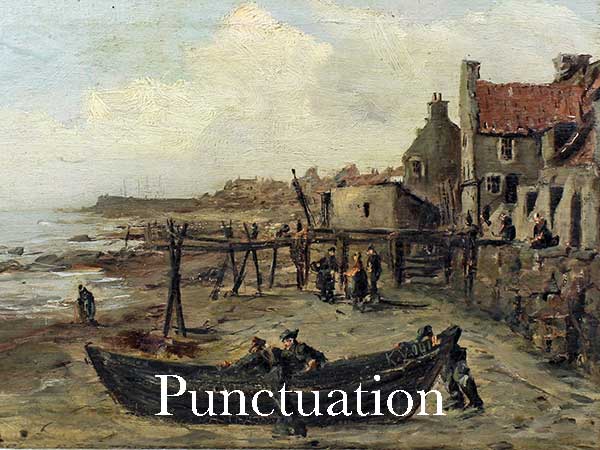
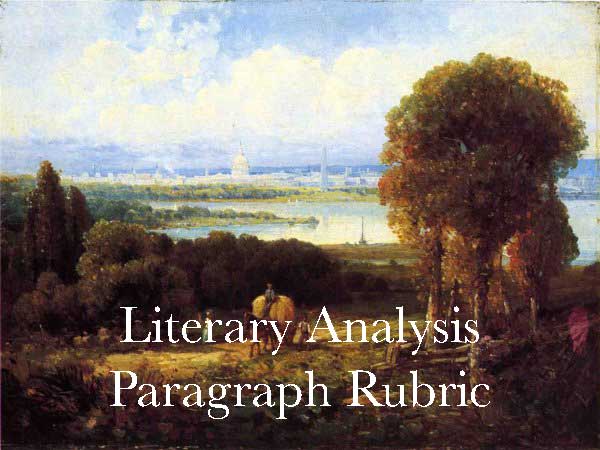
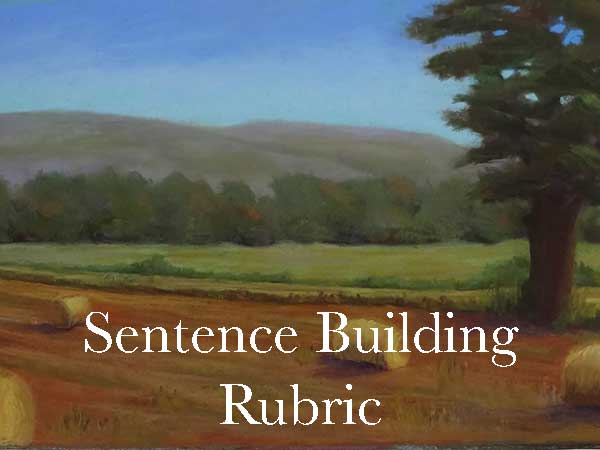
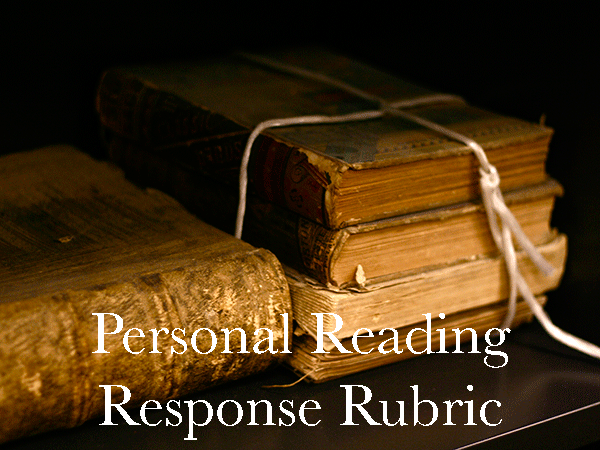

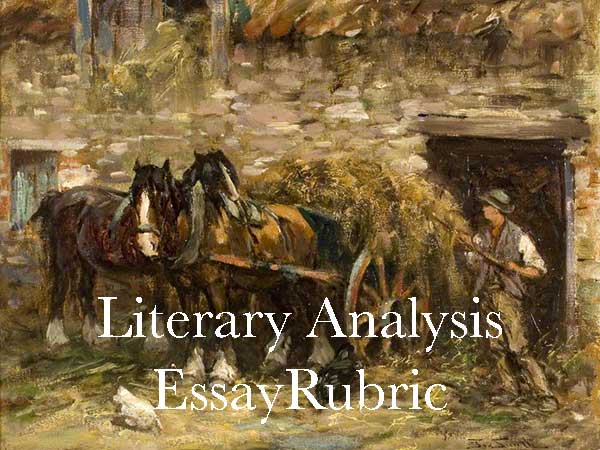
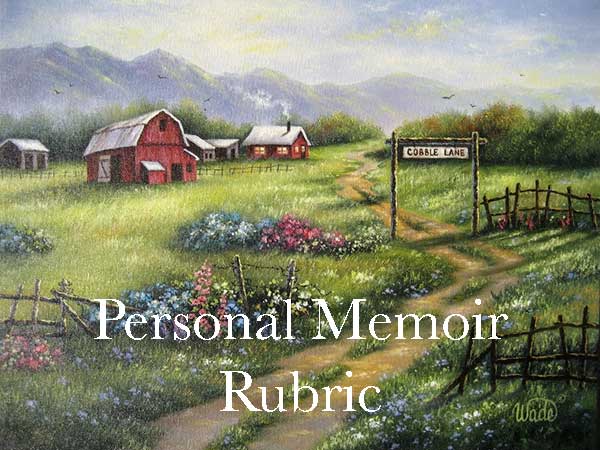
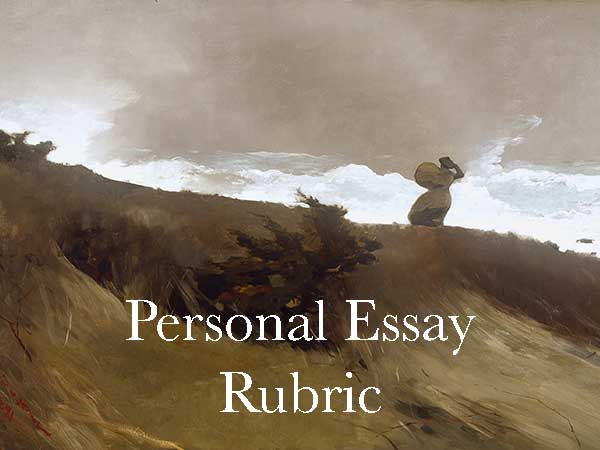
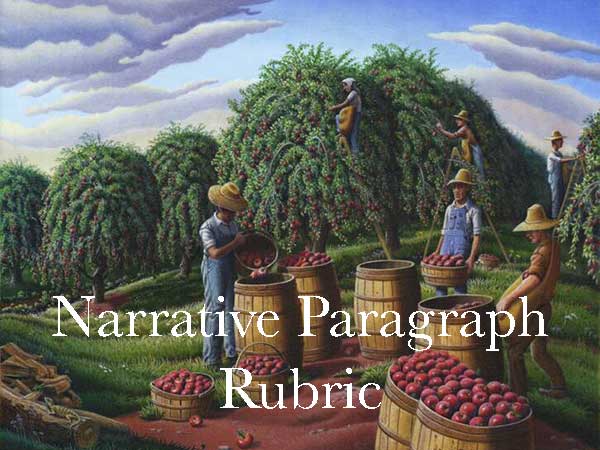
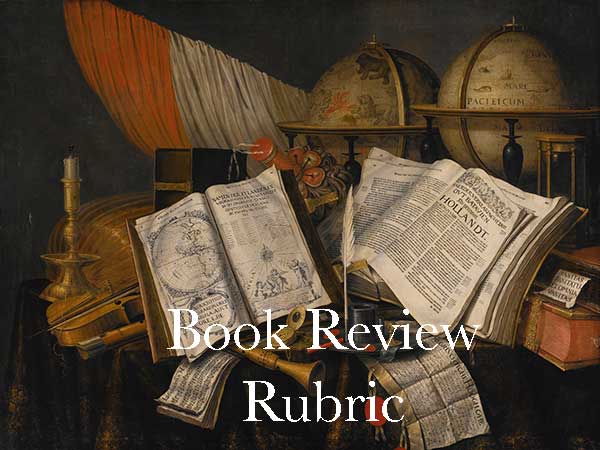
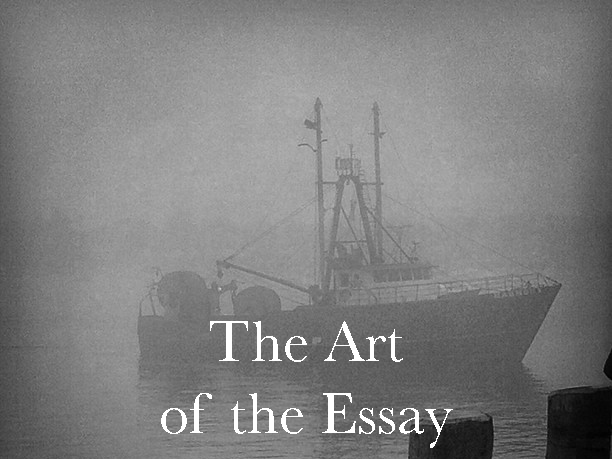
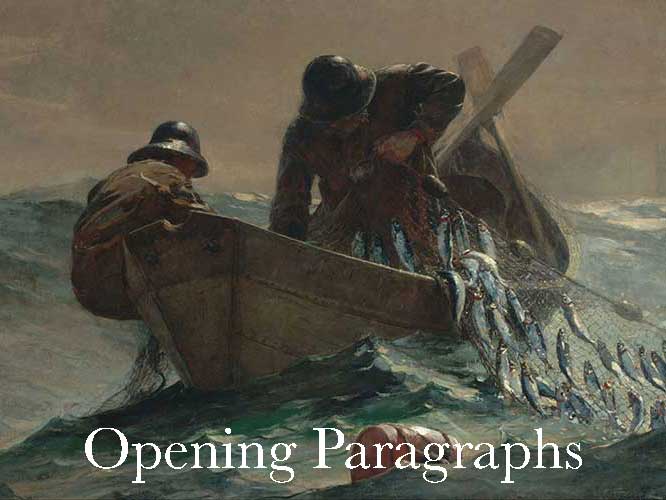
Workshop Videos…
How To Write a Narrative Paragraph
Write Better Sentences
The Narrative Paragraph Rubric
How To Create a Podcast
The Paragraph & Punctuation Power Workshop
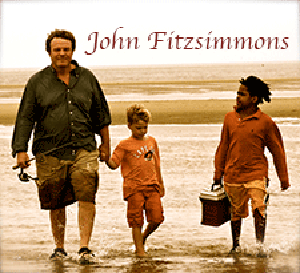
Contact Fitz
Workshop Rubrics
Word Docs…
P & P Narrative Paragraph Rubric
PDF’s…
P &P Narrative Paragraph Rubric
Use Quip…
More Links…
Listen to some songs…
Superman
Winter in Caribou
Trawler
James Joyce
Better pass boldly into that other world, in the full glory of some passion, than fade and wither dismally with age.
Henry David Thoreau
Write often, write upon a thousand themes, rather than long at a time, not trying to turn too many feeble somersets in the air–and so come down upon your head at last. Antaeus-like, be not long absent from the ground. Those sentences are good and well discharged which are like so many little resiliencies from the spring floor of our life–a distinct fruit and kernel itself, springing from terra firma. Let there be as many distinct plants as the soil and the light can sustain. Take as many bounds in a day as possible. Sentences uttered with your back to the wall. Those are the admirable bounds when the performer has lately touched the spring board.
(November 12, 1851)
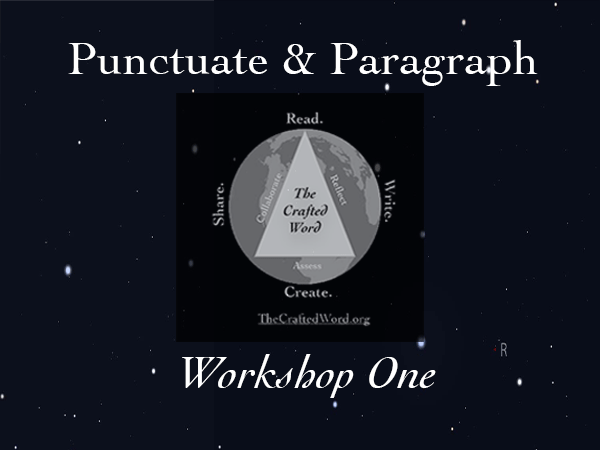
- Download the free iTunes U app before starting the course.
- Download the Pages app. It is a native app for the iPad, and is an excellent alternative for Microsoft Word that can be accessed on iPads, Mac computers–and it even has an online version, Pages for iCloud.
- NOTE: My courses can also be accessed via my website, TheCraftedWord.com, and for students without access to an iPad, I use Quip, (click here to join Quip) which allows my students and me to collaborate on shared documents. I find myself using Quip more and more often because it works equally well on all platforms: PC’s, Android, iPhones, iPads and tablets. If you join the course, you are welcome to use Quip to create and share your work with me. I will give you full access to all of my rubrics and writing exercises I have created in Quip. You simply need to go to our shared folder (I will provide a link to the folder) and make a copy of the document being used, and it will automatically be shared between me and you.
- Another important app to get is Notability, which I can use to give you written and even audio feedback on your work.
- The short story readings are linked to epub files that can be downloaded directly to your iTunes library. EPubs are great because they can be stored in your iBooks library; you can simply click a word for definitions, create notes and annotations, or simply highlight text–and it will all be sorted and organized for you in outline form for you to use in your writing pieces.
Workshop Curriculum
Paragraphing & Punctuation Units
Contact me if you would like to sign up for this course! Otherwise, feel free to use this workshop on your own.
 Welcome to The Crafted Word Paragraph & Punctuation course. I really need to create a better name, but I don’t need to create a greater purpose because learning to craft good paragraphs and to punctuate effectively is the most critical skill a writer needs to practice and master.The P&P course (I like the short version of the name) is an eight-unit series of writing and reading workshops that focus on developing solid narrative writing skills, effective paragraph writing skills, and practical and easy to remember rules for punctuation—especially comma usage, which comprise around 90% of grammatical mistakes in the writing pieces I assess.
Welcome to The Crafted Word Paragraph & Punctuation course. I really need to create a better name, but I don’t need to create a greater purpose because learning to craft good paragraphs and to punctuate effectively is the most critical skill a writer needs to practice and master.The P&P course (I like the short version of the name) is an eight-unit series of writing and reading workshops that focus on developing solid narrative writing skills, effective paragraph writing skills, and practical and easy to remember rules for punctuation—especially comma usage, which comprise around 90% of grammatical mistakes in the writing pieces I assess.
Each unit should take around six-eight hours of time to complete in a thorough manner—maybe a bit more if you really dig into the content, perhaps less if you are already a fairly skilled writer and proficient reader. The basic format for each unit is similar and includes: sentence building exercises, blogging, paragraph construction, and punctuation skills study and practice. Additionally, I like to include at least one 20-30 minute meeting via Skype or private tutorial to assess and reflect on your experience with each unit and to help you through any difficulties you may have.
These are the units for Unit One…
- Writing Exercises: Complete the assigned writing exercises using the attached rubrics.
- Blogging: You need to write at least one blog entry for each unit using my rubric for creating a “Fitz Style Blog Entry” rubric and two journaling entries of your own choice, which can include video entries, reviews, podcasts, gallery photos, travel journals, etc. I will offer feedback on each of your entries. All of the assigned written work should be posted on your blog after all of the editing and revision is completed. In this way, you will start to build up a diverse and compelling digital portfolio.
- Narrative Paragraph Writing: The first unit is geared towards “writing about experience.” Complete the first Rubric-based paragraph: “The Power of Family.” You may complete this on your own using whatever word-processing program you wish, though my preference is to use the document sharing program, Quip.com that allows for more collaborative and ongoing feedback.
- Personal Reading Response: Read a short story from my Classic Short Stories website, and then write a personal reading response using the rubric for this assignment.
- Punctuation: Study and complete the punctuation packet for each unit. If you have an iPad or Mac computer, I will send you a link to my Punctuation Workbooks on iTunes. All of my punctuation material is also available on my Punctuation website
- Final Reflection: Write a metacognitive reflection at the conclusion of your workshop.
Unit One: Blogging
Blogging
Practice the Life of a Writer
Over the course of my many years as writing teacher I have used blogging and blogging communities as a way to help students gain narrative fluency in their writing and to practice, in a sustained way, the one thing that all true writers do–which is to simply write. A writer who write regularly in a comfortable and unstructured setting will evolve into a writer who is more confident, capable and effective. It is really that simple.
If you do not have a blog already, I will set you up with a Crafted Word blog and guide you every step of the way towards creating a blog (and digital portfolio) which is compelling and even a lot of fun to use–as long as you use it!
Unit One Blogging Requirements:
- Daily Journaling: Complete at least two journal entries and post to your blog. Use your blog as a place to practice the art of daily journaling. I ask that you write at least two Daily journals are entries that are entirely up to you to create as you wish. Examples of daily journals can be simple recountings of what you did during the day, reflections on something you have been thinking about, narratives about experiences and travels you are doing or have done in the past–really anything that just gets you writing about something in particular. Do your best to punctuate, paragraphing proofread as well as you can–but it does not have to be perfect. Writing in your blog should never be an exercise that fills you with anxiety, it should just be a place to write as freely as you wish. For Unit One, you should write at least two daily entries.
- Fitz Style Entry: Use my rubric and create at least one “Fitz Style Blog Entry.” The Fitz-Style entry is a rubric-based approach to creating an casual journal entry that looks great, flows like a good essay, and captures some part of your life in a more disciplined way than a simple journal entry.
Upload a Word Doc Rubric
Upload a pdf version
Use Quip!
You may share your journal entries with me before posting, and I will help you edit and proofread your post before you publish to your blog.
Unit Two: Writing Exercises
Writing Exercises
How To Write Better Sentences
Exercise #1:
Adding Detail: One of the most common problems with sentences is that they just don’t tell the reader enough or give enough detail so that the reader feels informed and edified after reading the sentence. In the same way that any writing piece should always cover who/what/when/where/why, so should sentences—whenever possible. In many cases, this information might be in the sentence before or after, but it is certainly good practice to incorporate who/what/when/where/why into your sentences.
Below are two simple rules for helping to make your sentences more informative, detailed, and interesting to your readers.
Prompt: Write five sentences that include at least three of the who? what? when? where? and why? Details. The order of who/what/when/where/why is not important. Put the details (who, etc) within parentheses in bold.
e.g. The young soldier struggled all night (when) through the jungle (where) to reach his base camp before the enemy could reach him (why).
Post these sentences in the dropbox for this assignment.
- Put your sentence here
- Put your sentence here
- Put your sentence here
- Put your sentence here
- Put your sentence here
Exercise #2:
Adding Imagery and Action: It is our job as writers to spark our readers’ imaginations! A lot of writers forget that their readers are not “in their heads.” The readers can’t “see” anything that is not “specifically” described. Simply saying, “It was a cold day” can mean something completely different depending on the time of year or place on the planet. So, as you write, be conscious of your readers, and be sure to give them the needed imagery and actions to make your thoughts become more real to your readers.
Use specific imagery and actions to make these sentences more image rich.
• e.g. Ginny ran into the house. Ginny ran into the house like she was late for a date. (I used a simile to create an image)
• e.g. The red car pulled out of the driveway. The classic red Mustang convertible squealed out of the driveway and onto Birch Street. (I added descriptive adjectives and more detailed images and action.)
Now do the same for these sentences:
Post these sentences in the dropbox for this assignment.
- The tree fell in the woods.
- The plane flew through the sky
- I am not feeling well today.
- The baseball game was fun.
- I like ice cream.
Upload Word Doc
Sentence Building Exercise (Unit One)
Use Quip!
Unit Three: Narrative Paragraph Writing
The Narrative Paragraph Rubric
The Power of Family
Moreover, I, on my side, require of every writer, first or last, a simple and sincere account of his own life, and not merely what he has heard of other men’s lives
~Henry David Thoreau
So, here is my formula for writing a good narrative paragraph. In narrative writing we write about our own lives and thoughts and feelings, and so we write in the first person (except where noted).
This rubric is designed to help writers organize the flow and focus of a personal experience narrative paragraph. In a narrative paragraph, a writer writes from a personal point of view about something “worth writing about” in his or her life.
You should also view the videos on “How To Write a Narrative Paragraph” and “How To Use the Narrative Paragraph Rubric.”
Upload Rubric as Word doc
P & P Narrative Paragraph Rubric
Upload PDF Version
P &P Narrative Paragraph Rubric
Use Quip!
Access shared Quip document
Which version should I upload…
I have always been a big believer in using the text editing program that you like best. I have my own opinions–as I am sure you do, too! To that end, you have several options:
- If you upload the word doc, it works (of course) with Microsoft Word, and this document can also be opened in Pages (my editor of choice–especially if using an iPad). It will also open in Google Docs, Open Office, and several other popular text editors.
- Use Quip if you want to work on a shared collaborative document, which I do recommend if taking the workshop. Quip takes a little getting used to using, but it works amazingly well on any browser, tablet, or phone. It is similar to Google Docs, though I like the collaborative tools better in Quip–and I really love the clean and uncluttered interface–plus, I am doing some of my teaching in China, which does not allow Google anything right now. But if you are a Google sort, then it is certainly your choice to go Google.
- Upload the pdf if you want to print a hard copy to work with when away from a computer or if you want a version that can be uploaded to your iPad or Kindle as an ebook.
- All of The Crafted Word Rubrics are also located on the Resources and Rubrics page.
- If worse comes to worse, simply copy and paste the rubric directly from this site into the text editor you prefer to use.
Explore the rubric…
This rubric breaks a paragraph down into three areas:
- The first part of the paragraph introduces and narrow downs a theme from a broad theme (interesting and catchy enough to anyone) to a more narrow and focused theme that a writer can explore and explain in a single paragraph of 350 words or less, (but seldom less than 250 words).
- The central part of the paragraph (the setup and smoking gun) focuses on introducing and describing the experience that captures the essence and importance of your theme in a series of images and actions that tell the who, what, when, where, and why of the experience. (This is similar to text support or facts in expository or analytical writing). It proves the author has the authority and enough experience to write about this theme from the point of view of someone who has lived through the experience—and now has a story to tell that is meaningful, memorable—and above all, written with real and natural narrative voice.
- The last third of the paragraph (the head & heart and the conclusion or transition) explicates (which means to explain in detail) how the theme works within the experience the author just described. In the diagram you can see how the triangle starts small (narrow) and expands back towards a solid base. In practice, the writer should focus first on the parts of the experience that show the theme in action. Towards the end of the paragraph, the writer can (he or she does not have to) write about the importance of the theme in a more universal way.
- The closing line or transition will either be a brief and pithy conclusion or a sentence that transitions to a new paragraph that is logically linked together with the paragraph just completed.
NOTES
Read each section carefully to be sure you are following the flow of the rubric. A narrative writing piece needs to have the natural flow of human speech to be effective. If it is too choppy, it will be an ineffective piece because it won’t feel or sound real.
Remember that no writing piece is ever “done.” It is abandoned, and every minute before that time is a good time to “change” your paragraph for the better. Before you abandon this piece, let it sit for a couple of days, then go back to it with fresh eyes and a fresh mind and do what you need to do to make it more perfect—at least in your mind.
This rubric, if used wisely, is essentially a brief essay—and a damn good one if you give it the time and focus that well-crafted writing needs.
Paragraph Prompt: The Power of Family
No matter how a family is created, it is, for better or worse, the most universal theme and common thread that binds us all together as humans. Every family develops its own dynamic, their own way of doing things that they borrowed from traditions, religions, cultures, and often trial and error; but the basic fabric of a family is the same the world over—it is a group of people who are somehow brought together and figure out what it means to be a family.
Think of your own family and use this rubric to write a one paragraph reflection on some aspect of your experience with your family that illustrates the theme of the power of your family in a single experience in your life.
STEPS OF THE RUBRIC: Read each section carefully and try to follow all of the steps of the rubric. Read each section out loud or use text to speech and proofread carefully. A narrative should “sound” just like you would speak. Except better.
1. THE MAJOR THEME:
Writing out your theme as a single word or short phrase is a good way to help keep focused as you write the paragraph. Put your one word or short phrase theme centered on the page. It should constantly remind you that THIS is the theme you have to stay focused on throughout your paragraph!
The Power of Family
[Put your theme here]
2. GUIDING QUOTE:
If you are only writing a single paragraph, I think it is a great idea to put a quote above the paragraph that captures the mood, tone, and theme of your paragraph.
For example: if I wish to write about the power of family, I could use a quote like this, put in italics, with the author’s name below the quote.
Home is where when you get there,
they have to let you in.
~Robert Frost
[Put your text quote here]
3. BROAD THEME:
Write a short declarative statement that touches on a broad theme that all of us can relate to in some way or other. This acts as a “hook” that will attract your reader’s attention. Despite what you might wish, no one really cares about you when they read; a reader cares primarily about himself or herself. This broad theme is a theme that almost any person can relate to on some level, and hopefully it is intriguing enough to make your reader want to read on. Do not mention you or your family in this sentence!
For example: if you want to write about the importance of family, here is an example of a broad theme:
- It is only our immediate family that gives us unconditional love.
[Put your text here]
4. NARROW THEME:
Narrow down your theme by writing a phrase or sentence using the theme word that captures how your chosen theme is used in a specific way in the experience you are going to write about. Make sure it is “clear, concise and memorable” because this is what you want your readers to remember “as” they read your paragraph. This is the sentence that “steers” your reader in the direction you want your paragraph to go, and in that sense, it is what your paragraph is going to be about. YOU should be in this sentence; otherwise a reader may be misled into thinking you are merely writing about the importance of the theme, not about an experience you have had.
For example:
- It was my family that I turned to when I had no place left to go.
[Put your text here]
5. ONE/TWO PUNCH:
Follow your topic sentence with one or two more sentences that add detail or explanation to your topic sentence. These sentences can (and maybe should) be longer sentences. This helps to “narrow down” the focus of your paragraph so that you only have to write what can be fully explained in one paragraph.
For example:
- When I was alone in the world; when nothing was going my way, I knew that the door of family would always open always open for me and welcome me back into the arms of those people who love me without reservations.
[Put your text here]
6. SET UP:
The setup is the lead-in to your smoking gun. It prepares your reader for the description of your experience in the smoking gun by giving context to the experience.
- Who is there?
- What is happening?
- When is it happening?
- Where is it happening?
- Why is it happening?
[Put your text here]
7. SMOKING GUN:
When writing about a personal experience, chose a specific personal experience (or even a smaller part of an experience) that explicates, illustrates, and amplifies the theme of your paragraph. This personal experience is proof that you have been there and done that, which is why we call it the smoking gun! It is evidence that you are the one who had the experience that only YOU can write about with full authority. When you write the smoking gun, be sure to include as much detail as needed—the who? what? when? where? and why?—to fully capture the theme of your paragraph.
For example:
- At no other time in my life was this more obvious than when I returned to my family home in Concord after a long journey to the China to discover the essential truth about life. Broke, disheveled, and disenchanted, I stood on the doorstep and tentatively rapped on the door. No smile was wider than my mom’s; no arms were wider than my dad’s as they pulled me into their arms and into the living room I left so long ago.
[Put your text here]
8. HEAD & HEART:
Show your reader your thoughts! Write as many more sentences as you “need” (but at least three more) to illustrate and elaborate upon whatever you introduced in your theme-setting sentences. This is where you reflect upon your experience and describe the ways that your experience reflects your broad and barrow theme.
For example:
- It didn’t matter that I left home without even telling them where I was going. It didn’t matter that I had once criticized their lives as dull and meaningless, and it didn’t matter that I never called and never wrote. It only mattered that I was home again with my family.
[Put your text here]
9. GET OUT or GO ON!
This sentence either wants to close out your thoughts or “transition” to a potential new paragraph.
For example:
- For me, it only matters that I will never turn my back on my family again because when times are tough, family is all that really matters.
[Put your text here]
10. Copy and Paste Completed Paragraph Here:
In sit amet nulla semper, sodales eros vel, porta dolor. Aenean tincidunt accumsan tortor ut scelerisque. Nunc interdum risus eu magna consequat, eu elementum nisl commodo. Curabitur ut ullamcorper mi. Pellentesque quis suscipit metus, vel lobortis nunc. Duis semper neque et libero fringilla, euismod tempor lacus dignissim. Morbi nec dui ipsum. Nulla quis pellentesque erat. Lorem ipsum dolor sit amet, consectetur adipiscing elit. Mauris eget ex diam. Phasellus eu justo eu tortor convallis lobortis.Duis non dignissim sem. Etiam accumsan gravida fringilla. Morbi lacinia malesuada posuere. Vivamus posuere tortor risus, ut placerat orci interdum commodo. Aliquam nec molestie quam, pharetra luctus orci. Nullam non finibus turpis, quis euismod quam. Vestibulum ante ipsum primis in faucibus orci luctus et ultrices posuere cubilia Curae; Cras vehicula augue quis lectus lacinia, sit amet fermentum massa condimentum. Praesent pulvinar est lacus, sit amet mattis sem pretium eu. Sed nec bibendum erat. Curabitur vitae lorem felis. Nullam mauris nibh, consectetur a tortor non, interdum porta nunc. Quisque elit justo, volutpat ut hendrerit vel, mattis in mauris. Etiam risus quam, volutpat eu augue sed, posuere pellentesque lectus.
THE POTSAID RULE OF THREE:
Proofread, Edit, Revise, & Submit
- Literature is abandoned, not finished! Go back and re-read what you have written.
- Find three areas or sentences that you can make better. If you can’t or won’t do this, then you are light years away from being a writer.
- Often you can find a better broad or narrow theme sentence somewhere else in the paragraph. You can almost always find a more clear and effective way to write a sentence than you wrote on your first try.
- If the rule of three was too easy (meaning you easily found mistakes) do it again…and again if you have to.
*When you are convinced you have done all you can, submit your final review as required by your teacher or editor.
Unit Four: Personal Reading Response
Personal Reading Response
How To Write a Literary Reflection
I am sure that many of you have been asked to do in-class or summer reading of some sort—and I bet, too, that your teachers will ask you to write something about a book, poem or story—or even just a chapter—that you have read. My Personal Reading Response Paragraph Rubric can help you write an awesome and meaty paragraph that is insightful, well-organized, and interesting. Try it!
A personal reading response needs to feel and sound like you speaking at your very best, and it needs to be both honest and thoughtful. Being thoughtful means that you are careful and considered and real in your writing. Being honest means being authentic. Genuine praise is enlightening to a reader; false praise reeks of arrogance.
You can use this rubric when you are asked to—or desire to—craft a “personal” response to a piece of literature. Read the descriptions of each step of the rubric on the left side, and then insert your sentences into the boxes on the right side of the rubric. When you are completed, paste the full paragraph below the rubric.
Your completed response should be between 300-500 words.
1. Assignment Details:
- Follow all of the formatting requirements .
- Follow the directions for each step of the rubric.
- Be sure to “try” and match what you write with the directions for each stage of the rubric.
2. The Broad Theme (Opening Paragraph)
The Hook
Every writing piece needs a good and pithy “hook” to gain and grab the readers attention.
- Without even mentioning the title, write a brief, single sentence that tries to capture the attention of your audience by stating the major theme of your personal reading response.
- The way you craft this sentence sets the direction, tone and mood of the reflection that follows.
[Insert your text here]
3. Narrow Theme: (Opening Paragraph)
Get Specific
- In the second sentence, introduce the piece of literature, the genre of the piece, and the author, as well as the major effect the writing piece had on you personally.
- Remember that book titles are italicized.
- Short story, song, and poem titles are put in quotes.
[Insert your text here]
4. One/Two Punch: Opening Paragraph
What is the Author Trying To Do?
Every writer writes for a reason, and when doing so he or she tries to get the reader to feel or think in a certain way.
- Write two or three more sentences that tells your reader what “you” feel the author is trying to do in the writing piece.
- For added emphasis and support, you could also include a researched quote from another source to back up your thoughts.
[Insert your text here]
5. Smoking Gun: (Second Paragraph)
Summary & Text Reference
Briefly, using three to five sentences, summarize the story, poem, or song. It is important to give a brief summary of the writing piece because it helps your reader put the writing piece in context. This does not mean, however, to give away all of the details and spoil it for your reader.
- Who: who is or are the major characters?
- Where: where is the action happening?
- When: when is the action taking place?
- What: what is the main conflict that is happening?
- Why: why is this conflict happening?
[Insert your text here]
6. Head & Heart: (Third Paragraph)
Metacognition
Remember that in a personal response, you can’t be wrong―as long as you are truthful. In this section of your paragraph write honestly from your head and heart about your experience reading and understanding the text. Below are some ideas for how to approach this paragraph, but please expand the list to suit your response.
Here are some ideas, but don’t answer these like a list of questions! Weave them into a narrative paragraph that flows “conversationally.” You can’t be wrong here, but you can write in a way that is dull and boring to your readers.
- How did the writing piece affect you? Was it exciting, boring, interesting, dull…why?
- What emotions did it make you feel?
- Did you relate to the content or the characters in some way, shape or form?
- Did it challenge you to think and feel in a different way?
- Did it change any part of your own world view?
- Did it bring up memories of other books or authors you have read?
[Insert your text here]
7. Get Out: Fourth Paragraph
Elevator Review Conclusion
The conclusion is as important as the hook, so do your best to make the end of your paragraph as interesting and refreshing as your opening sentence.
- Imagine that someone in an elevator asked you about what you are reading, and you only have ten seconds to respond.
- You can touch on what you have already written, but don’t use the same words again.
- Really, it should not take more than ten seconds to read this last paragraph!
[Insert your text here]
8. Paste, Proofread & Publish
Do What Writers Do
Paste each step of the rubric in the space below. Proofread, edit and revise as needed. Publish as required by your instructor.
- The rubric is a guide, not a rigid structure. If it sounds too academic it will lose the power of a narrative essay.
- Revise your sentences and paragraphs to create a narrative voice that mimics your real voice.
- Pay close attention to formatting, punctuation, grammar and mechanics.
- Add more paragraphs if you feel it will be more effective for your readers.
- Have fun with your words, and your readers will have more fun reading!
[Insert your text here]
Unit 5: Punctuation
Punctuation
Comma Rules 1-3
Study the punctuation rules below and complete the assigned quizzes and exercises. If you have an iPad, you may download my book “Fitz’s Top Ten Comma Rules” and use that as an interactive approach to learning the major comma rules.
#1: Commas in a Series of Elements
A Series of Elements
Things to know…
- Commas are used to separate three or more words or phrases (elements) in a list or series.
- “Sometimes” (though rarely) a list of clauses can be separated with commas.
- Commas can separate clauses, but only if the comma precedes a coordinating conjunction
- If you connect two clauses with a comma, you create the dreaded “comma splice.”
- You may omit the last comma [which is called the Oxford Comma] if there will be no confusion in meaning.
- If there are only two elements, no comma is needed between the elements.
Rules…
Commas are used to separate three or more words or phrase in a list or series.
- e.g. Please bring skates, gloves, hats and food to the rink. [with words]
- e.g. I am tired of you always forgetting your books, forgetting your assignments, and forgetting to bring a pencil to class. [with phrases]
Commas can separate clauses, but only if the comma precedes a coordinating conjunction.
- e.g. I am going to the mall, and I am going to the Apple store, but I am not going to buy anything.
- e.g. I heard my mother calling, so I walked home, and I found a ball, a bat, three quarters and one old shoe on the way home.
If you connect two clauses with a comma, you create the dreaded “comma splice,” which is in my top ten writing mistakes of all time.
- e.g. I am going fishing, I will use my new fishing pole.
- To “repair” a comma splice you can add a period and make two sentences:
- e.g. I am going fishing. I will use my new fishing pole.
- Or you can add a comma and a conjunction:
- e.g. I am going fishing, so I will use my new fishing pole.
- Or you can replace the comma with a semi-colon:
- e.g. I am going fishing; I will use my new fishing pole.
You may omit the last comma [which is called the Oxford Comma] if there will be no confusion in meaning.
- e.g. I love pizza, milk, and french fries. [three items with an Oxford Comma=no confusion]
- e.g. I love pizza, milk and french fries. [three items without an Oxford Comma (but milk and french fries might not be good mixed together:)
- I tend to use the Oxford Comma more often than not because why risk confusing the reader.
If there are only two elements, no comma is needed between the elements.
- e.g. I love pizza and french fries.
- e.g. I despise the Rangers and Redwings.
If you are introducing a list with a noun, use a colon to introduce the list.
- e.g. Don’t forget these important items: my books, pencil, baloney, and peanut butter and fluff sandwich.
- e.g. Today is a proud day: you graduated from school; you have been offered a good job, and you are moving out of the house.
If you introduce the list with a verb use a comma after the first item in the list:
- e.g. Don’t forget to bring my books, pencil, baloney, and peanut butter and fluff sandwich.
- Note how important the Oxford Comma is here. Without it, a reader might infer that someone should bring a baloney and peanut butter sandwich, which is kind of gross:)
#2: Commas with Coordinating Conjunctions
Things to know…
- So, yet, and, or, nor, for, and but are the seven coordinating conjunctions
- A comma and a conjunction can always be replaced with a period or semi-colon instead of the comma and conjunction.
- Soyet Andor Norforbut only work as conjunctions if they are connect two or independent clauses together
- If the sentence is brief, a comma is not required before the conjunction
Commas with conjunctions must have an independent clause (meaning, the clause can stand alone as a sentence) BEFORE and AFTER the conjunction and comma.
- e.g. I need to buy a new computer, so I am going to the mall.
- e.g. It is a cold day, yet it is a beautiful day on the mountain.
- e.g. Sally is happy today, and she is feeling better.
- e.g. I am either going to climb the mountain, or I am going to die trying.
- e.g. I am neither talented, nor is there a place for me on the team.
- e.g. Do not show up at my house, for I am not going to be home today.
- e.g. I am not a good basketball player, but I am an amazing baseball star.
A comma and a conjunction can always be replaced with a period or semi-colon instead of the comma and conjunction.
- It is raining, so I am not going to school. [comma and conjunction]
- It is raining; I am not going to read. [semi-colon]
- It is raining. I am not going to study comma usage. [period]
Soyet Andor Norforbut only work as conjunctions if they are connecting two or more independent clauses together to create a compound sentence; otherwise, they are being used in different ways.
- e.g. You are so cool! [Here “so” is being used as an adverb]
- e.g. I am not done, yet. [Here yet is being used as an adverb that indicates time.]
- e.g. I play soccer and tennis in the summer [Here “and” is being used to connect a series of two items]
- Here are some more example where a comma is “not”needed:
- e.g. I don’t like fish or fowl.
- e.g. I don’t like swimming nor sailing. [Here nor is being used as a conjunction to negate the ???
- e.g. Finally, my car is for sale!
- e.g. She loves everyone but me.
If the sentence is brief, say eight words or less, it is perfectly fine to leave out the comma as there
- e.g. I don’t want to and you don’t want to!
- e.g. Give it back or you’ll regret it.
- e.g. She’s pretty but she’s not happy.
- e.g. Give me some money so I can go!
#3: Commas with Introductory Elements
Introductory Elements
Things to know…
- An introductory element is any word, phrase or dependent clause that comes before the main independent clause of the sentence
- Introductory words are usually names, adverbs, salutations or interjections
- Introductory phrases set up or place in context the main clause of the sentence, and so are usually prepositional or adverbial phrases
- Introductory clauses are always dependent because the clause contains a subject and a verb, but it is not a completed thought
An introductory element is any word, phrase or dependent clause that comes before the main independent clause of the sentence.
- Introductory words are usually names, adverbs, salutations or interjections
- e.g. Actually, Fred can take the test. [introductory adverb]
- e.g. Fred, be careful taking the test. [introductory name]
- e.g. Oh, Fred should be careful taking the test. [interjection]
- Introductory phrases generally act to set up or place in context the main clause of the sentence, and so are usually prepositional or adverbial phrases.
- An adverbial phrase simply modifies some sort of action (a verb) by telling a reader:
- when some action happened
- where some action happened
- how some action happened
- how much some action happened
- e.g. Without thinking, he ran into the burning building and saved his goldfish. [This is an adverbial phrase: the word without modifies the verb thinking]
- e.g. Before dinner, I plan on taking a nap. [This is a prepositional phrase: the word before modifies the noun dinner]
- as far as comma usage goes, knowing whether the phrase is a prepositional phrase or an adverbial phrase does not really matter.
- All that really matters is that you–the writer–reccognize the phrase as a phrase introducing and/or modifying the independent clause that likely follows.
- whether or not the comma is “needed” can be the choice of the writer depending on if you want the reader to pause at that point in time.
- e.g. Without a second thought he saved his goldfish.
- Only a fool or a pedantic old teacher would be perplexed by the lack of a comma in this sentence.
- Introductory clauses are always dependent or subordinate clauses (different name for essentially the same thing) because the clause contains a subject and a verb, but it is not a completed thought. To muddy the water even further, some folks call these clauses restricted or unrestricted clauses.
- e.g. Because it is snowing, I am not going to school.
- e.g. After the snow falls tonight, school will surely be canceled tomorrow.
- e.g Provided our headmaster is a wise man, we will surely get the day off tomorrow
- e.g. Since you don’t seem to care, we will have school tomorrow!
- A dependent/subordinate/restricted clause always has a “word” before the clause (marked in red in the example). This is often called the dependent marker word.
- Below is an incomplete list of possible dependent marker words introducing a dependent clause:
- rather, even though, once, whenever, although, until, if only, whereas, as long as, because, before, as if, after, whether, etc…
[cap_iframe_loader type=’iframe’ width=’100%’ height=’600′ frameborder=’0′ src=’http://www.thecraftedword.org/wp-content/uploads/adobe_captivate_uploads/Dependent_and_Independent_Clauses2/index.html’]
Punctuation Quizzes & Exercises
The punctuation quizzes and exercises for Workshop One will be posted in here.
Unit Six: Metacognition
When you finished all of this work, write a metacognition of at least 300 words using the narrative paragraph rubric to help guide the structure and flow of this reflection on your experience. Post the finished reflection to your blog.
And you’re done. Congratulations. It is time to move on the next workshop.
Check out some more Crafted Word Offerings…
The Crafted Word Blog…
Remember the Time
Write what you know. ~Mark Twain I don’t always practice what I preach, especially when it comes to the simple, unaffected, and ordinary “journal entry.” Much of my reticence towards the casual journal entry is the public nature of posting our journal writing as...
Remote Learning 2.0
Explore, Assess, Reflect & Rethink How to move on to a better tomorrow... For most of us teachers, our first crash course in remote learning is done, and the wise work now is to separate the wheat from the chaff and truly assess what works and what can be...
The Farmer, the Weaver & The Space Traveler
Words matter. Words carefully crafted and artfully expressed matter infinitely more. There is something compelling in a turn of phrase well-timed, arresting image juxtaposed on arresting images; broad ideas distilled into clear, lucid singular thought. For the...
Swing, dammit, swing…
What’s so important about this literary analysis paragraph thing? Maybe you won’t be spending your life analyzing literature. Maybe this is some academic exercise that is ultimately no big deal in the greater scheme of your life.Or maybe it is…You will always be...
Embrace the Beast
The Rules of Punctuation If you don’t use it, you lose it... ~Fitz What do you really need to learn? What teaching and what practice will help you learn what you “really need to learn” in a way that will somehow stay with you and be useful and necessary to...
Ten Tips for a Great Narrative Essay
So much depends on the red wheelbarrow glazed with rain water beside the white chickens. -William Carlos Williams It was funto be swimming and clambering around with my kids yesterday in a remote stream in the Berkshires and thinking: "This would be a cool...

